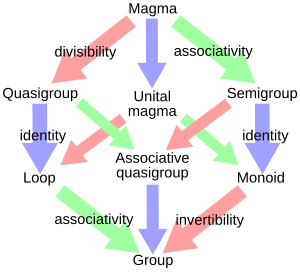Abstract Algebra/Binary Operations
A binary operation on a set is a function . For , we usually write as .
Properties[edit | edit source]
The property that for all is called closure under .
Example: Addition between two integers produces an integer result. Therefore addition is a binary operation on the integers. Whereas division of integers is an example of an operation that is not a binary operation. is not an integer, so the integers are not closed under division.
To indicate that a set has a binary operation defined on it, we can compactly write . Such a pair of a set and a binary operation on that set is collectively called a binary structure. A binary structure may have several interesting properties. The main ones we will be interested in are outlined below.
Definition: A binary operation on is associative if for all , .
Example: Addition of integers is associative: . Notice however, that subtraction is not associative. Indeed, .
Definition: A binary operation on is commutative is for all , .
Example: Multiplication of rational numbers is commutative: . Notice that division is not commutative: while . Notice also that commutativity of multiplication depends on the fact that multiplication of integers is commutative as well.
Exercise[edit | edit source]
- Of the four arithmetic operations, addition, subtraction, multiplication, and division, which are associative? commutative and identity?
Answer[edit | edit source]
| operation | associative | commutative |
|---|---|---|
| Addition | yes | yes |
| Multiplication | yes | yes |
| Subtraction | No | No |
| Division | No | No |
Algebraic structures[edit | edit source]

Binary operations are the working parts of algebraic structures:
One binary operation[edit | edit source]
A closed binary operation o on a set A is called a magma (A, o ).
If the binary operation respects the associative law a o (b o c) = (a o b) o c, then the magma (A, o ) is a semigroup.
If a magma has an element e satisfying e o x = x = x o e for every x in it, then it is a unital magma. The element e is called the identity with respect to o. If a unital magma has elements x and y such that x o y = e, then x and y are inverses with respect to each other.
A magma for which every equation a x = b has a solution x, and every equation y c = d has a solution y, is a quasigroup. A unital quasigroup is a loop.
A unital semigroup is called a monoid. A monoid for which every element has an inverse is a group. A group for which x o y = y o x for all its elements x and y is called a commutative group. Alternatively, it is called an abelian group.
Two binary operations[edit | edit source]
A pair of structures with one operation can used to build those with two: Take (A, o ) as a commutative group with identity e. Let A_ denote A with e removed, and suppose (A_ , * ) is a monoid with binary operation * that distributes over o: a * (b o c) = (a * b) o (a * c). Then (A, o, * ) is a ring.
In this construction of rings, when the monoid (A_ , * ) is a group, then (A, o, * ) is a division ring or skew field. And when (A_ , * ) is a commutative group, then (A, o, * ) is a field.
The two operations sup (v) and inf (^) are presumed commutative and associative. In addition, the absorption property requires: a ^ (a v b) = a, and a v (a ^ b) = a. Then (A, v, ^ ) is called a lattice.
In a lattice, the modular identity is (a ^ b) v (x ^ b) = ((a ^ b) v x ) ^ b. A lattice satisfying the modular identity is a modular lattice.
















